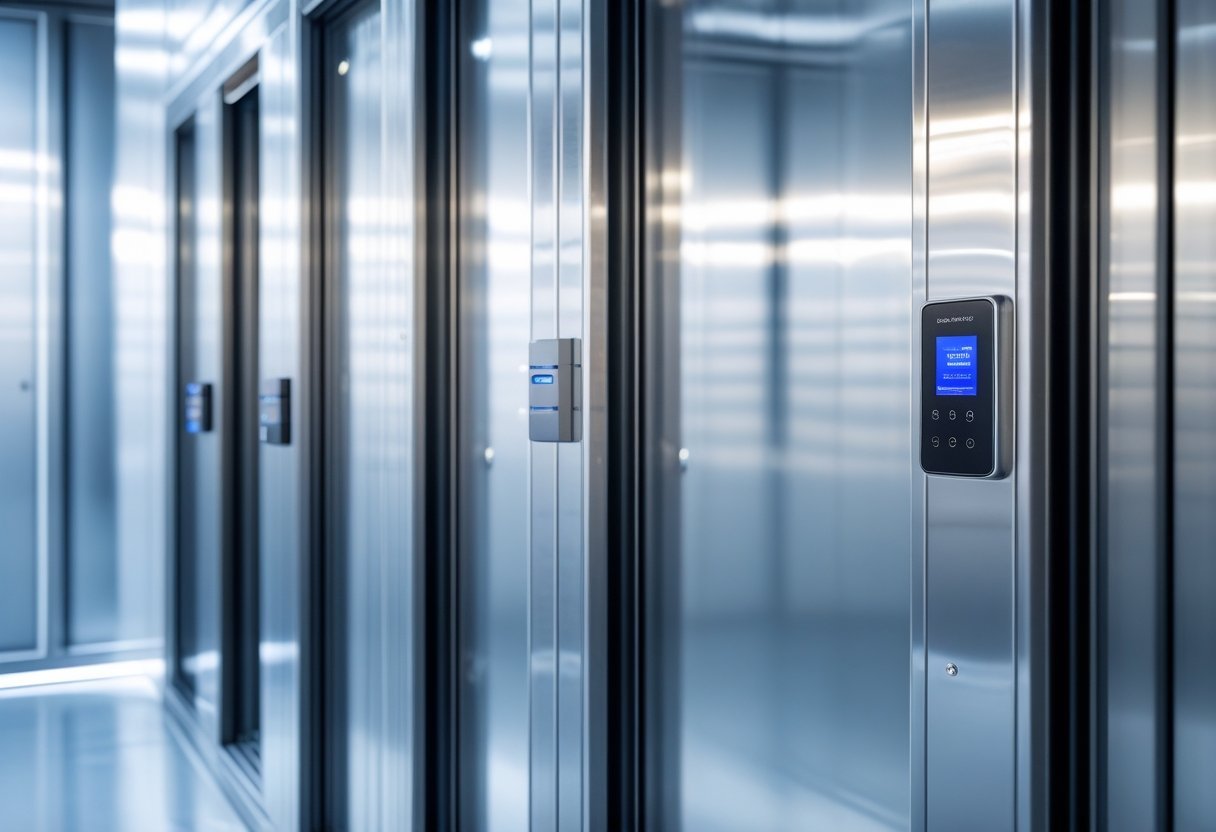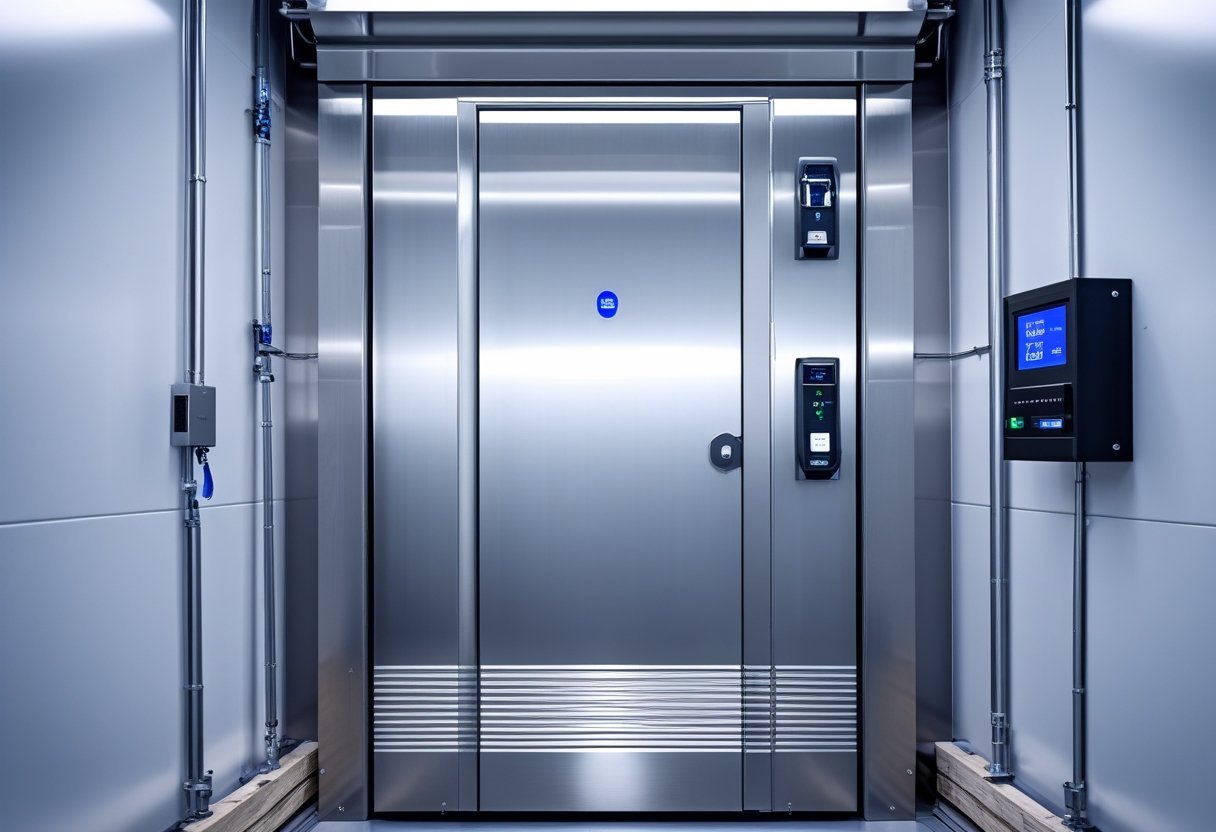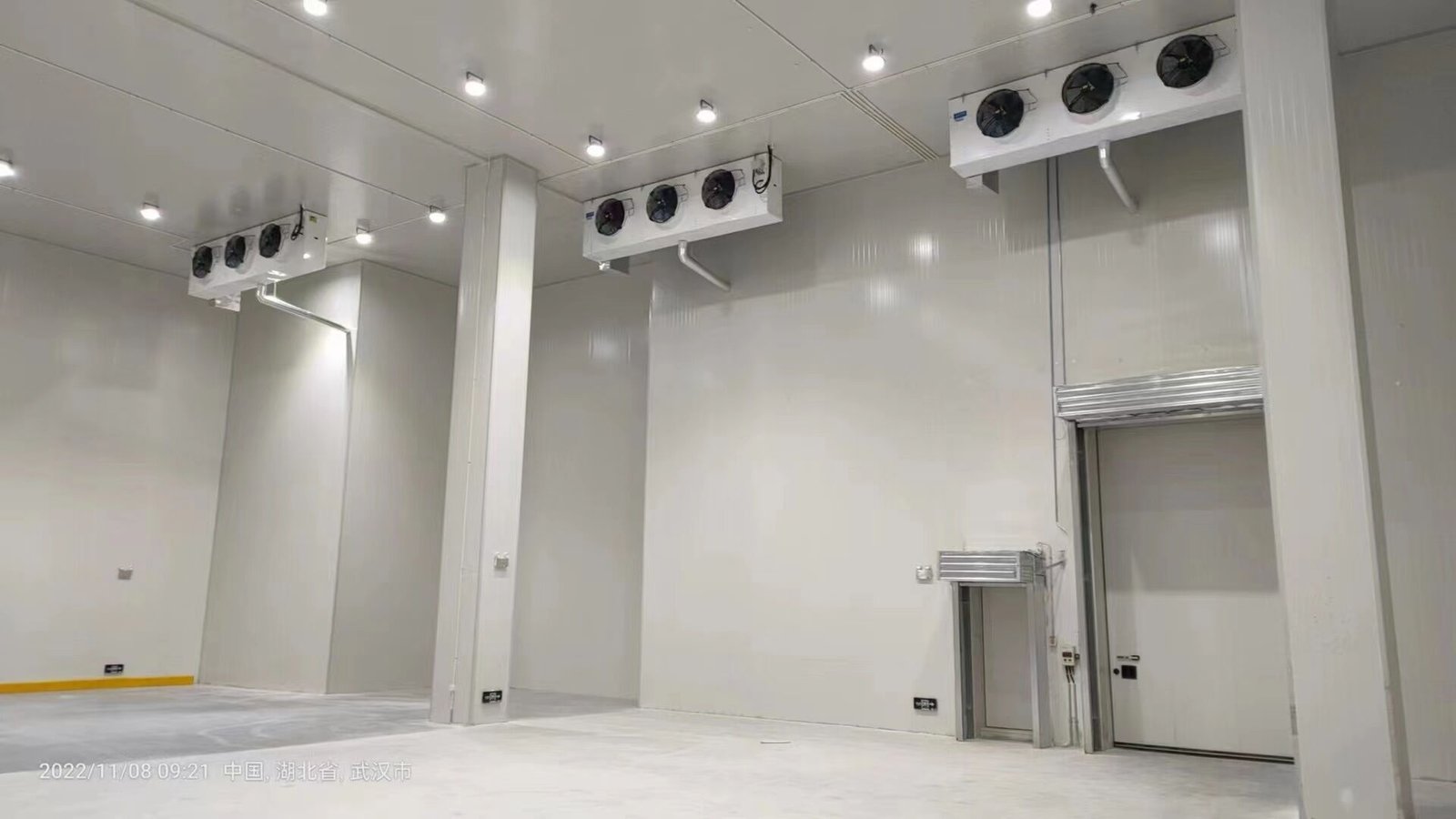Cold storage facilities require specialized doors that can maintain temperature control while providing secure access to valuable inventory. Custom-sized cold room doors with stainless steel 304 frames and RFID access control offer precise temperature management, durability, and advanced security for commercial refrigerated spaces. These doors solve common problems like energy loss, unauthorized access, and maintenance issues that plague standard cold storage solutions.

Modern cold room operations demand doors that can withstand extreme temperatures while maintaining structural integrity. Stainless steel cold storage doors use 304 or 316 grade steel construction that resists corrosion and provides long-lasting performance in harsh environments. The combination of custom sizing and RFID technology creates a complete access control system that tracks entry while preserving energy efficiency.
Commercial facilities benefit from doors that integrate seamlessly with existing refrigeration systems and security protocols. Cold storage door manufacturers now offer solutions that combine insulation properties with smart technology features. These advanced doors reduce operational costs through better temperature control and enhanced security monitoring capabilities.
Key Takeaways
- Custom-sized doors with stainless steel 304 frames provide superior durability and corrosion resistance for cold storage applications
- RFID access control technology enables secure entry tracking while maintaining energy efficiency in refrigerated environments
- Professional installation and proper materials selection significantly reduce long-term maintenance costs and operational expenses
Key Features and Technologies of Custom-Sized Cold Room Doors

Modern cold room doors combine advanced materials, smart access systems, and flexible sizing options to meet specific facility requirements. These features work together to provide energy efficiency, security, and reliable performance in demanding cold storage environments.
Stainless Steel 304 Frame Construction
Stainless steel 304 frames offer superior corrosion resistance in cold storage environments. This grade contains 18% chromium and 8% nickel, making it ideal for food processing facilities and pharmaceutical storage.
The material resists rust and bacterial growth. It maintains structural integrity at temperatures ranging from 32°F to -40°F without becoming brittle or warping.
Key Properties of 304 Stainless Steel:
- Corrosion resistance: Withstands moisture and temperature fluctuations
- Hygiene compliance: Easy to clean and sanitize
- Durability: Maintains strength across temperature ranges
- Low maintenance: Requires minimal upkeep compared to painted steel
The frames support heavy insulated panels while maintaining airtight seals. Cold storage door manufacturers often use reinforced locking mechanisms with stainless steel components.
Some manufacturers apply anodized coatings to aluminum components. This process creates a protective oxide layer that enhances corrosion resistance and extends component lifespan.
RFID Access Control Integration
RFID systems provide secure, hands-free access to cold storage areas. Users carry proximity cards or key fobs that activate door mechanisms without physical contact.
The technology works in extreme cold conditions where traditional keypads may fail. RFID readers function reliably at temperatures as low as -40°F.
RFID System Components:
- Card readers: Wall-mounted units that detect authorized credentials
- Access cards: Programmed with unique identification codes
- Control panels: Manage user permissions and door operations
- Backup systems: Manual overrides for emergency situations
Access logs track entry and exit times for security monitoring. Administrators can add or remove user permissions remotely without changing physical locks.
Integration with existing security systems allows centralized management. The technology supports multiple authorization levels for different storage zones within facilities.
Customization Options and Door Sizing
Custom cold room doors accommodate unique facility layouts and operational requirements. Standard sizes often don’t fit existing openings or workflow patterns.
Door thickness varies based on temperature requirements. Refrigeration doors typically measure 60-80mm thick, while freezer applications require 80-120mm panels for proper insulation.
Available Door Types:
- Sliding doors: Save space in narrow corridors
- Swing doors: Traditional hinged operation for standard openings
- Vertical lift doors: Overhead operation for dock areas
- Impact-resistant models: Withstand forklift traffic
Width and height dimensions adjust to existing structural openings. Cold storage door specialists measure existing frames to ensure proper fit and seal integrity.
Handle placement, window locations, and hardware specifications customize functionality. Some facilities require vision panels for safety monitoring or specific handle heights for accessibility compliance.
Insulation core materials match temperature requirements. Polyurethane foam provides excellent thermal performance while maintaining structural strength across custom dimensions.
Performance, Materials, and Security Considerations

Stainless steel 304 frames deliver exceptional strength and corrosion resistance for cold room applications. Proper thermal insulation prevents energy loss while maintaining consistent temperatures, and regular maintenance ensures long-term reliability.
Durability and Corrosion Resistance
Stainless steel 304 frames provide superior resistance to moisture, chemicals, and temperature fluctuations common in cold storage environments. This material contains 18% chromium and 8% nickel, creating a protective oxide layer that prevents rust formation.
The 304 grade performs well in temperatures ranging from -40°F to 150°F. It resists corrosion from cleaning chemicals and sanitizers used in food storage facilities.
Custom cold storage doors with stainless steel frames last 15-20 years with proper maintenance. The material’s non-porous surface prevents bacteria growth and makes cleaning easier.
Anodized aluminum components can supplement stainless steel in areas requiring lighter weight materials. However, stainless steel 304 remains the preferred choice for door frames due to its structural integrity.
Regular inspection of welds and joints prevents potential failure points. Proper installation techniques protect against thermal expansion and contraction cycles.
Thermal Insulation and Energy Efficiency
High-performance cold storage doors require polyurethane foam insulation with R-values between 25-35. This insulation maintains temperature differentials while reducing energy consumption.
Thermal bridging occurs when metal conducts heat through door frames. Quality doors use thermal breaks or gasket systems to minimize this effect.
Key insulation features:
- Foam-in-place polyurethane core
- Continuous perimeter sealing
- Magnetic gaskets for airtight closure
- Double-wall construction
Energy savings reach 15-25% compared to standard doors. Temperature control systems work less to maintain set points when doors seal properly.
Infrared thermography testing identifies thermal leaks during installation. This ensures optimal performance from day one.
Installation and Maintenance Best Practices
Professional installation prevents alignment issues and ensures proper sealing. Door frames must be plumb and square within 1/8 inch tolerance for optimal operation.
Installation requirements:
- Level foundation and properly sized opening
- Adequate clearance for door swing or slide
- Electrical connections for RFID systems
- Proper anchoring to structural elements
Monthly maintenance includes cleaning gaskets, checking hardware, and testing RFID access controls. Cold storage door manufacturers recommend quarterly professional inspections.
Lubrication of hinges and tracks prevents premature wear. Use food-grade lubricants in food storage applications.
RFID access control systems require battery replacement every 2-3 years. Software updates ensure compatibility with facility management systems.
Replace gaskets every 3-5 years or when compression set occurs. Damaged gaskets compromise thermal performance and increase energy costs.
Frequently Asked Questions
Cold room door selection involves balancing insulation performance, access control technology, and material durability. These questions address key considerations for residential installations, commercial energy efficiency, and specialized applications.
What are the essential features to look for in residential cold room doors?
Residential cold room doors need proper insulation thickness of at least 4 inches to maintain temperature stability. The door should have triple seals around the perimeter to prevent air leaks.
A reliable latch system with interior safety release prevents accidental lockouts. Heavy-duty hinges rated for frequent use ensure long-term operation.
Temperature ratings should match the intended storage conditions, typically ranging from 32°F to -10°F for home applications. The door frame must fit precisely to avoid gaps that compromise efficiency.
How does the insulation quality of a commercial freezer door affect energy efficiency?
High-quality insulation reduces heat transfer by up to 30% compared to standard options. Polyurethane foam cores provide superior thermal resistance with R-values between 6-8 per inch.
Poor insulation forces refrigeration systems to work harder, increasing energy costs by 15-25% annually. Premium insulation materials help maintain consistent temperatures with less energy consumption.
Thermal bridging through metal components can negate insulation benefits. Thermal breaks in the frame construction eliminate these heat transfer paths.
What maintenance procedures should be followed for stainless steel 304 frame cold room doors?
Regular cleaning with mild detergent and warm water prevents corrosion and maintains appearance. Avoid chloride-based cleaners that can damage the stainless steel surface.
Door seals require monthly inspection for cracks, tears, or compression loss. Replace damaged seals immediately to maintain thermal efficiency.
Hinges and hardware need quarterly lubrication with food-grade lubricants. Check mounting bolts for tightness every six months to prevent structural issues.
Condensation drainage systems require cleaning to prevent ice buildup. Clear drain lines monthly in high-humidity environments.
Can you integrate RFID access control with existing sliding freezer door systems?
RFID systems can retrofit onto most existing sliding door mechanisms. The access control unit mounts separately from the door operator for easier installation.
Power requirements include 12V DC supply for the RFID reader and door strike mechanism. Low-temperature rated components ensure reliable operation in freezer conditions.
Programming allows multiple access levels and time restrictions for different users. Audit trails track entry and exit times for security monitoring.
Battery backup systems maintain access control during power outages. Integration with building management systems enables remote monitoring and control.
What are the options available for cleanroom door customization?
Door sizes can accommodate openings from 3×7 feet up to 12×12 feet for equipment access. Custom dimensions ensure proper fit without field modifications.
Surface finishes include brushed, mirror polish, or textured stainless steel to meet cleanroom standards. Flush mounting hardware eliminates crevices where contaminants collect.
Window options use double-pane tempered glass with thermal breaks. Vision panels help maintain workflow visibility while preserving environmental control.
Specialized seals meet FDA and USDA requirements for pharmaceutical and food processing applications. Magnetic or inflatable seals provide superior contamination barriers.
How do insulated doors contribute to the overall performance of a basement cold room?
Proper door insulation prevents condensation on interior surfaces that leads to mold and structural damage. Vapor barriers integrated into door construction control moisture migration.
Basement installations require additional attention to air sealing due to temperature differentials. Insulated doors reduce thermal bridging that causes frost formation.
Energy efficiency improves by 20-40% with properly insulated doors compared to standard basement doors. This reduces operating costs and equipment wear.
Door positioning affects air circulation patterns within the cold room. Proper placement ensures even temperature distribution throughout the storage space.



